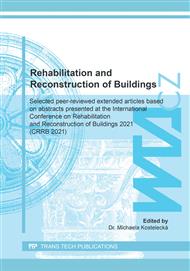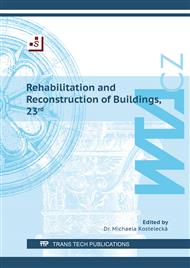p.3
p.9
p.15
p.23
p.31
p.39
p.45
p.55
Investigation of the Effectiveness of the Rehabilitation of Historical Constructions Using Wireless Dehumidification Technologies
Abstract:
The humidity of historical constructions can be considered as a global problem causing either partial or complete destruction of the affected buildings. Therefore, it is necessary to solve this problem by certain interventions to reduce or completely remove humidity from these structures in order to preserve the historical and cultural heritage of the nation. This paper will describe a summary of previous theoretical and practical knowledge of the issue. This part will be followed by research dealing with the effectiveness of non-invasive methods of combating humidity in buildings carried out in situ, specifically the technology of wireless dehumidification known as the magnetokinetic method. The paper will describe two historical objects, investigated in situ, where these technologies were applied several years ago. As these technologies are highly questioned by the professional public, this research is expected to help demonstrate the effectiveness of this technology on the basis of real values obtained directly from practice.
Info:
Periodical:
Pages:
15-21
Citation:
Online since:
September 2022
Authors:
Price:
Сopyright:
© 2022 Trans Tech Publications Ltd. All Rights Reserved
Share:
Citation:



